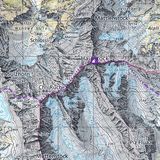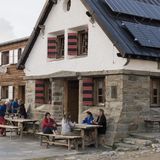
© Swisstopo (5701325910)
Keys SAC route portal / SAC-App Disciplines, keys and icons explained
The routes are shown on swisstopo maps (legends map symbols for the Swiss national maps). For each mountain sport discipline the cartographic symbols and the type of line give specific information about the terrain and the requirements (see also the SAC grading scales). Lines and map symbols are shown in the colour of the respective discipline:
Mountain sport and symbols
Mountain and alpine hiking are classified into six grades according to the T grading system: from T1 (hiking) to T6 (difficult alpine hiking), where T stands for trekking.
More about mountain and alpine hiking
-
Solid line: leg of the route without alpine requirements, normally on a (marked) hiking trail or mountain hiking trail, difficulty up to T3.
-
Dashed line: higher alpine requirements: some exposed and precarious passages occur, more difficult orientation in pathless terrain. As a rule difficulty from T4.
High alpine alpinism tours are classified into six grades according to the SAC grading system for alpine tours from L (easy) to EX (extremely difficult).
-
Solid line: hike on marked/faint trails
-
Dashed line: hike on non marked/faint trails.
-
Dotted line: pathless terrain, in which the details of the itinerary cannot be charted on the map, e.g. on glaciers or in rocky terrain. The actual itinerary may vary.
Climbing routes are graded according to the French grading system after the most difficult single passage on the climb. If known, in multi-pitch routes the obligatory difficulty is additionally indicated in brackets. 6a (5b), for example, means that the route is rated 6a when freeclimbed, while the obligatory difficulty to be freeclimbed between the bolts is 5b.
-
Dashed line: approximate itinerary of the climb, if chartable on the map (e.g. ridges or slightly steep faces and pillars).
The itinerary of a ski tour charted on a map is to be understood as a general indication. The actual itinerary may vary depending on the conditions. Ski tours are classified according to the SAC ski touring grading system into seven grades from L (easy) to EX (extremely difficult). The grading concerns exclusively the part of the route that is done on skis. Especially for high alpine tours, the passages that are climbed on foot can be the crux passages, which can significantly increase the overall difficulty. In this case the mountaineering passages are indicated under "Remarks" or "Key passages".
-
Solid line: approximate itinerary of the ski tour.
-
Solid line: this leg of the route requires increased caution.
-
Dotted line: this leg is normally climbed on foot (from a ski depot and back).
The itinerary of snowshoe hikes charted on a map is to be considered an approximate guideline. The actual itinerary may vary depending on the conditions. Snowshoe hikes are classified according to the WT grading system into six grades: WT1 (easy snowshoe hike) up to WT6 (challenging alpine snowshoe tour), where "WT" stands for "winter trekking".
-
Solid line: Approximate itinerary of the snowshow tour.
Around 40,000 further routes are available in the SAC route archive. The unchanged route descriptions are from the "Alpine Tours" series and can be downloaded in PDF format under the corresponding destinations. The SAC route archive is activated with the button to the right of the discipline filters, the available tour destinations are shown in sepia (brown) on the map.
The contents of the route archive are available to all SAC members or with a tour portal subscription.




